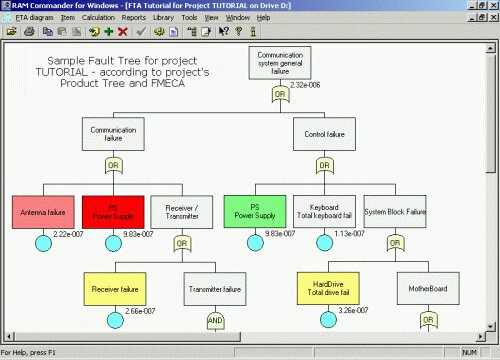A Fault Tree Analysis (FTA) is a systematic deductive, top-down method of analyzing system design and performance. It involves specifying a top event to analyze (such as catastrophic system behavior), followed by identifying all of the associated elements in the system that could cause that top event to occur. It clearly identifies fault relationships and provides a methodical approach to predict the probability that some top-level events will or will not occur.
This analysis is often applied to identify critical design and/or safety weaknesses early in the development process. It is also useful for the development of diagnostic approaches.
RAM Commander’s FTA software module (Fault Tree Analysis) is one of significant components in the unique scope of the RAM Commander features. It implements and summarizes the first-hand experience gained by the ALD FTA experts in hundreds of projects where they used RAM Commander and other ALD software.
FTA Module Features
• Up-to-date, intuitive and powerful fault tree diagram interface with possibilities of full control over the diagram: elements location, colors, styles, zooms etc.
• Convenient ways of diagram printing and simple Copy & Paste transfer to other applications
• Easy to use and reusable Events Library
• Calculation of Unavailability, Mean Unavailability, and Minimal Cut Sets.
• Calculation of Importance and Sensitivity
• Calculation of Frequency, Intensity, Uncertainty (release 2009)
• Set of required reports – tree, tree diagram, events library, MCS etc.
• Connection between FTA and product tree/reliability module
• Connection between FTA and FMECA
• Automatic creation of the fault tree from FMECA
• Automatic creation of the fault tree from Potential Process/Design FMEA
• Automatic creation of the fault tree from RBD (release 2009)
• Unique graphical FTA Unavailability Improvement by regulation of basic events parameters (release 2009)

FTA Basics
Fault Trees are one of the most widely used methods in system reliability and failure probability analysis. A Fault Tree is a graphical representation of events in a hierarchical, tree-like structure. It is used to determine various combinations of hardware, software, and human error failures that could result in a specified risk or system failure. System failures are often referred to as top events. A deductive analysis using a Fault Tree begins with a general conclusion or hazard, which is displayed at the top of a hierarchical tree. This deductive analysis is the final event in a sequence of events for which the Fault Tree is used to determine if a failure will occur or, alternatively, can be used to stop the failure from occurring. The remainder of the Fault Tree represents parallel and sequential events that potentially could cause the conclusion or hazard to occur and the probability of this conclusion.
Types of Analysis Conducted using Fault Trees
• Qualitative analysis: performed by means of Minimal Cut Sets (MCS) building
• Quantitative Analysis: it is Calculation of Absolute probabilities, i.e. probabilities of system failures (mean unavailability, unavailability for time T etc.)
FTA Module Reports
• Minimal Cut Sets
• Tree diagram
• Basic events
• Tree output
• Unavailability(t) Chart
• Importance / Sensitivity Analysis
See also:
RAM Commander Fault Tree Analysis Software module.
Other Failure Analysis Methods and Tools
Download the latest version of RAM Commander V8.7 (July 2019)
